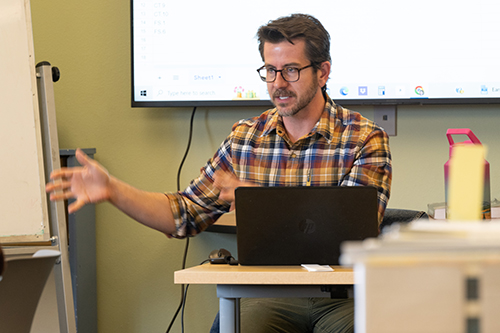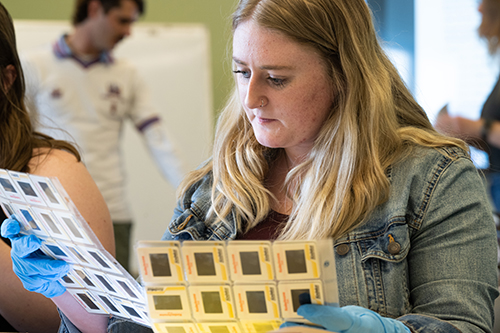UM Environmental History Students Bring Order to Massive Photo Collection
MISSOULA – Chalk it up to pure chance.
Last winter, Professor Eric Zimmer, a visiting scholar of the American West in the University of Montana’s History Department, was looking for a chunky project that students in his spring U.S. Environmental History Class could tackle.
The Montana Natural History Center meanwhile had been sitting for two years on a collection of around 75,000 slides – 86 boxes worth – donated by the estate of nature enthusiast and photographer Dr. Herman William “Bill” Gabriel, which the MNHC, despite a strong desire, didn’t have the staff to catalog.
“I reached out the center,” Zimmer recalls, “and told them about this class and just asked if there was something we could do to help them out and support their mission. They said, ‘Yeah, we have these boxes of materials, and we’d like to get a handle on what’s all there and figure out what to do with it.’”
“It was perfect,” MNHC Collections Manager Alyssa Cornell said of Zimmer’s timing. “We brainstormed ideas, and when I brought up the Gabriel collection Eric’s eyes lit up. We both got very excited.”

UM Visiting Professor Eric Zimmer and his students approached the collection as valuable snapshots of the natural environment from several decades ago.
Zimmer and Cornell knew from a natural history perspective there would be gems filed away in the hundreds of sleeves assembled by Gabriel, an alumnus of UM’s College of Forestry and longtime MNHC supporter. Determining what was worth keeping and what was out of scope for the MNHC – and its focus on the natural wonders of the West – would be the challenge.
“Natural history is more than specimens. It’s writing, it’s science, it’s photography,” said Cornell, who provided the students with a background on the MNHC and Gabriel before the inventory began. “We knew most of it would be in scope for us and potentially put on display or used in student lectures. And, as much as we’d like to keep everything, Bill traveled to Thailand and Kenya, and it just wouldn’t quite fit with what we do.
"We hope to eventually find homes in other collections for those that aren’t in scope,” she added.
From his perspective, Zimmer and his students approached the collection as valuable snapshots of the natural environment from several decades ago.
“One of the things we’ve talked about as a class is that, although some images were going to be visually stunning, the value is not necessarily artistic but in what they document,” Zimmer said. “The value is in the fact that, 50 or 100 years from now, environmental historians will have a better understanding about what these landscapes and wildlife populations looked like and how issues like climate change are affecting them.”
To give the project structure, Zimmer designed the class to simulate a historical consultancy project. The students acted as a consulting firm, MNHC their client and Zimmer the project manager. Professor Donna McCrea and Professor Erin Baucom, archivists from the UM Mansfield Library Archives and Special Collections, acted as advisers.
Professor Kyle Volk, chair of UM’s History Department, said the class format exemplifies a focus of the public history program, which bridges classroom and experiential learning to prepare students for the job market and graduate school.
"An essential goal of our program,” Volk notes, “is to connect history students to public institutions and to immerse them deeply in projects that they can refer to in applications and job interviews. This project with the Natural History Center certainly fit the bill, and students are already reaping the benefits.”
Lauren Kimzey, a history major from Hamilton, said the class was an invaluable experience for her because she hopes to be a professional archivist when she graduates. Having the class on her resume will be an important step toward that ambition, whether going to work after graduation or graduate school, she said.

During the class, Kimzey explained, students split into groups assigned to 10 to 15 boxes each.
“My project was some of the more ambiguous boxes that maybe weren’t in scope,” said Kimzey, who works at the Mansfield Library as a student employee in the archives department and will intern this summer at Fort Missoula. “He (Gabriel) was definitely a windmill enthusiast, which was fun to look at but probably won’t fit in scope.
“And there were a lot from Yellowstone National Park from the ’70s, which were cool,” she added.
In addition to the inventory work, a group of students also wrote a biography on Gabriel to accompany the collection and be used in future exhibitions. Another group made recommendations on how MNHC could enhance the accessibility of its existing exhibits – a piece of the project that emerged from an accommodation for a visually-impaired student.
The project concluded with a presentation to MNHC staff on the student’s conclusions, which came wrapped in a massive and detailed spreadsheet that staff can use when making final decisions on the collection.
“I was so impressed with the engagement students had with the project,” said Thurston Elfstrom, MNHC executive director. “This class was much more like an intensive internship, really, and Eric is a remarkable professor who’s inspiring future historians.”
The project, Elfstrom added, builds on the close partnership between UM and MNHC. UM faculty frequently lend their expertise to center exhibits, and some of the wildlife on display is on loan from UM’s Dr. Philip L. Wright Zoological Museum.
“The class was really about preparing students to continue in this field, but an important second piece is that UM believes it has a public service role as part of its mission,” Zimmer said. “That means reaching out and supporting nonprofits and facilitating relationships. It makes all the sense in the world to be talking and collaborating.”
###
Contact: Dave Kuntz, UM director of strategic communications, 406-243-5659, dave.kuntz@umontana.edu.